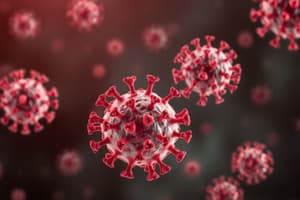Podcast
Questions and Answers
How do Natural Killer (NK) cells induce apoptosis in infected cells?
How do Natural Killer (NK) cells induce apoptosis in infected cells?
- By expressing the fas ligand or releasing perforins and granzymes (correct)
- By secreting antibodies
- By activating the infected cell
- By engulfing the infected cell
What is the role of the fas ligand in NK cell-induced apoptosis?
What is the role of the fas ligand in NK cell-induced apoptosis?
- Binding to the fas molecule on the infected cell to trigger apoptotic signals (correct)
- Enhancing cell survival
- Blocking the immune response
- Inhibiting virus replication
How do perforins contribute to NK cell-induced apoptosis?
How do perforins contribute to NK cell-induced apoptosis?
- Activating virus replication
- Preventing apoptosis
- Deactivating NK cells
- Forming pores in the membranes of infected cells (correct)
Why are the mechanisms of NK cells particularly effective against virally infected cells?
Why are the mechanisms of NK cells particularly effective against virally infected cells?
What happens if apoptosis is induced in an infected cell before the virus completes its replication process?
What happens if apoptosis is induced in an infected cell before the virus completes its replication process?
Which proteins released by NK cells are involved in triggering apoptosis intracellularly?
Which proteins released by NK cells are involved in triggering apoptosis intracellularly?
What is the main function of pattern recognition receptors (PRRs) in the innate immune response?
What is the main function of pattern recognition receptors (PRRs) in the innate immune response?
Why is the variety of pattern recognition receptors (PRRs) limited in cells of the innate immune system?
Why is the variety of pattern recognition receptors (PRRs) limited in cells of the innate immune system?
How does the strategy of the innate immune system in using a limited number of receptors differ from that of the adaptive immune system?
How does the strategy of the innate immune system in using a limited number of receptors differ from that of the adaptive immune system?
Which feature distinguishes pattern recognition receptors (PRRs) from adaptive immune receptors?
Which feature distinguishes pattern recognition receptors (PRRs) from adaptive immune receptors?
What limits the variety of pattern recognition receptors (PRRs) present on the cell membrane?
What limits the variety of pattern recognition receptors (PRRs) present on the cell membrane?
Why do innate immune cells have a limited number of pattern recognition receptors (PRRs) compared to adaptive immune cells?
Why do innate immune cells have a limited number of pattern recognition receptors (PRRs) compared to adaptive immune cells?
What is the main function of innate immune cells when they encounter a pathogen they recognize?
What is the main function of innate immune cells when they encounter a pathogen they recognize?
Which type of receptor is commonly found on innate immune cells for recognizing bacterial components and complement?
Which type of receptor is commonly found on innate immune cells for recognizing bacterial components and complement?
What is the main function of chemokines in the innate immune response?
What is the main function of chemokines in the innate immune response?
Which type of soluble mediator is responsible for inducing a receiving cell to change its physiology?
Which type of soluble mediator is responsible for inducing a receiving cell to change its physiology?
In the context of the immune response, what does chemotaxis refer to?
In the context of the immune response, what does chemotaxis refer to?
Why do cytokines play a crucial role in immune responses?
Why do cytokines play a crucial role in immune responses?
Flashcards are hidden until you start studying




